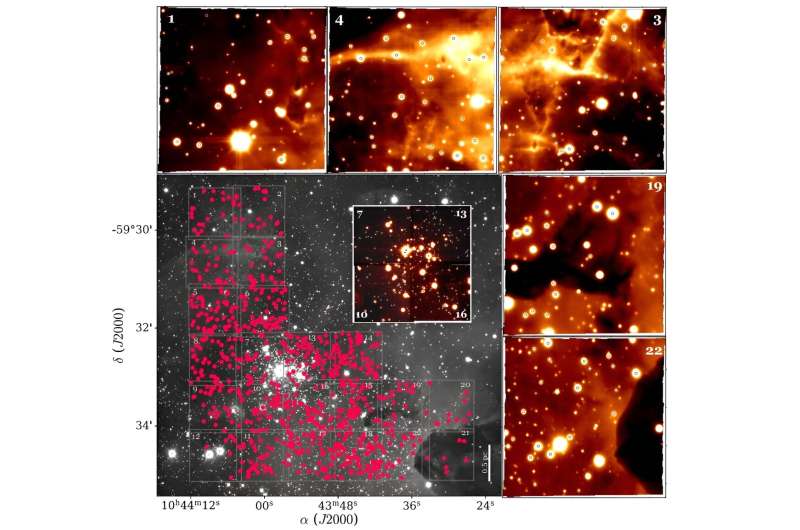October 3, 2023 report
This article has been reviewed according to Science X's editorial process and policies. Editors have highlighted the following attributes while ensuring the content's credibility:
fact-checked
preprint
trusted source
proofread
Study investigates the population of young low-mass stars in Trumpler 14

Using the Very Large Telescope (VLT), European astronomers have performed spectroscopic observations of an open cluster known as Trumpler 14. Results of the observational campaign, published September 25 on the pre-print server arXiv, shed more light on the properties of young low-mass stars in this cluster.
Open clusters (OCs), formed from the same giant molecular cloud, are groups of stars loosely gravitationally bound to each other. To date, more than 1,000 of them have been discovered in the Milky Way galaxy. Expanding the list of known galactic open clusters and studying them in detail could be crucial for improving our understanding of the formation and evolution of our galaxy.
At a distance of some 9,000 light years from the Earth, Trumpler 14 (or Tr 14 for short) is a Galactic OC located in the Carina Nebula. It has a mass of approximately 4,300 solar masses, diameter of six light years, and is estimated to be about 1 million years old. Therefore, it is one of the most massive, young, and compact clusters in the Carina Nebula Complex (CNC).
A team of astronomers led by Dominika Itrich of the European Southern Observatory (ESO) has employed ESO's VLT in order to explore young low-mass stars in Trumpler 14. Observations were carried out in 2016 with the Multi Unit Spectroscopic Explorer (MUSE), a second generation integral field unit (IFU) instrument on VLT.
The team investigated 780 stars in Trumpler 14, obtaining spectral and stellar properties for 717 of them. It turned out that 339 stars in the sample are of spectral type K, and 269 were classified as M-type stars. The remaining objects are mostly late G-type stars.
According to the paper, about half of the stars in the sample have masses below 1 solar mass, and the least massive star has a mass of only 0.17 solar masses. Therefore, the study conducted by Itrich's team is the most deep to date in terms of masses—when it comes to CNC. It also shows that detailed examination of low-mass stars is possible in the massive but distant regions.
Based on the distribution of stellar ages of stars in Trumpler 14, the astronomers derived the cluster age of approximately 1 million years, thus consistent with previous results. However, they underlined that this is a robust result as the estimate is not affected by the choice of evolutionary tracks.
The researchers concluded that their study could help us better understand the formation and evolution of low-mass stars in a cluster environment.
"Low-mass stars are the most common in the Galaxy but at the same time the most vulnerable to environmental conditions. Presented here, [the] stellar characteristics of the few hundreds of low-mass stars provide a step [towards] the better understanding of formation and early evolution of low-mass stars in the massive cluster," they explained.
More information: Dominika Itrich et al, The population of young low-mass stars in Trumpler 14, arXiv (2023). DOI: 10.48550/arxiv.2309.14168
Journal information: arXiv
© 2023 Science X Network





















